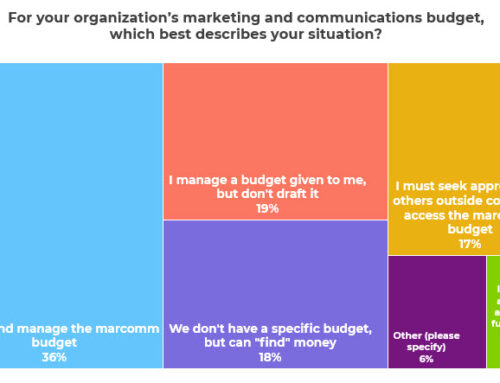Creating a nonprofit marketing budget is much like growing and tending plants – though kind of in reverse.
You have to ensure you have all the right ingredients and components necessary to help your activities grow and flourish.
And as you go through the process, you have to diligently monitor to ensure everything is moving as it should. Regularly checking for pesky surprise guests or deviations is essential because, without proper attention, things can dry up quickly and, in the worst case, wither to an irreversible halt.
Let that happen, and you’ll have a tough chance at receiving a healthy quantity of plants (or dollars) again. However, if you do it all the right way, you will witness the blooming growth of your nonprofit’s impact. Your carefully nurtured marketing efforts will yield fruitful results.
And if you think you don’t need them, good luck trying to operate without them. Get it? Plants need oxygen to survive, and marketing needs funds to thrive.
Digging In
On the serious side, marketing budgets help you become aware of just how much of your nonprofit org’s budget is being used to support goals like:
- Promoting and amplifying services
- Enhancing donor communications
- Increasing community engagement
- Expanding outreach efforts
And a dedicated marketing and communications budget helps ensure your strategy is in alignment with these and other organizational goals.
As you discuss and itemize a proposed yearly budget with finance or leadership, you are really discussing the strategic marketing plans to support the overall organizational plans. How much goes where is a reflection of your future strategy.
Benefits of having a budget
Creating a nonprofit marketing budget is a great opportunity to clarify and co-align your marketing and communications vision with your staff, colleagues, and leadership while also organizing and compartmentalizing your efforts.
It also helps you analyze which of your strategies and tactics are working down the road. Spent $25,000 on that billboard last two quarters, but no one called the custom number? Could be something to look at next go around.
We also need to show impact and return on investment (ROI) for our marcomm activities and your budget is the starting point for that. Your spend is your baseline for your return.
And if you can’t measure your activities now, starting with a budget and baseline goals, how can you adjust it for the future?
Creating the marketing budget
What will you need?
- A marketing strategy – as mentioned earlier, a well-defined marketing strategy serves as the foundation for your budgeting process. It outlines your goals, target audience, key messages, and the tactics you’ll employ to achieve your objectives.
- An organizational strategy – to create an effective marketing strategy, you need to align it with your overall organizational strategy. When your organizational goals change, your marketing plan and budget must adapt accordingly. For instance, if your strategic plan involves a significant increase in the number of people served, it will have a direct impact on your marketing activities. Planning how to support and promote this growth becomes a crucial component of your marketing strategy and budgeting process.
- Historical data and performance analysis – reviewing past marketing initiatives and their outcomes can provide valuable insights. Analyzing the performance of previous campaigns, the return on investment (ROI), and key metrics can help inform your budget allocation decisions. By understanding what has worked in the past and what hasn’t, you can optimize your resources and improve the effectiveness of future marketing efforts.
By incorporating these three elements into your budgeting process, you’ll be better equipped to allocate resources strategically, align your marketing activities with organizational goals, and maximize the impact of your nonprofit’s marketing initiatives.
Learn more about creating a marketing strategy here.
Getting to a final
In some cases, marketing funds may be charged as overhead, meaning they are allocated from a general budget pool. In other cases, the budget could be charged directly to specific services or programs. And in certain scenarios, it may be a combination of both approaches. Your finance team will help you understand exactly how it works and how they arrive at your final approved number.
This is important to understand and emphasizes the importance of your relationship, or at least, communication, with your finance and accounting teams.
Making good with finance
A good partnership with finance can be key. Having one allows you to:
- Gain access to the most recent financial information: Whether it’s your specific budget performance, variances from the plan, or the overall organizational finances, the finance team can help you access the necessary documents or systems to view this information.
- Create new line items as your plans evolve: Line items and allocations help you track your spending accurately. For example, if you’re planning to incorporate social media ads or digital advertising in the future, but haven’t done so before, you can request the finance team to create a new line item, such as “digital advertising” or “advertising.” This ensures these costs are properly allocated, avoiding them getting lost within other categories during review.
- See the bigger financial picture: By partnering with finance, you gain visibility into not only your own financial goals and performance but also those of the larger organization. This broader perspective allows you to understand the ripple effects on your operations and adjust your plans accordingly.
- Leverage finance expertise in budget creation: Finance folks often have the experience at creating budgets and can be a good resource to support you in this entire process.
What’s in it?
Salaries, outside labor, advertising costs, promotional items, staff training, equipment, shared costs like building rent, and supplies – the list goes on! Each should have its own code or item line for tracking.
When planning costs, don’t forget about the big picture. Good tactics need good staff and reliable vendors. Consider the value of quality when estimating expenses.
Once finalized, know what can be cut if needed. Keep the essentials but also include nice-to-haves. In reality, some things may get cut. Make sure the non-essential items take the hit, not the critical ones.
When do I need to do it?
The best time to start working on your marketing and communications budget is now.
It’s crucial to begin the budgeting process well in advance, ideally before the start of the fiscal year, to allow ample time for strategic planning and thoughtful allocation of resources. Your finance team typically has a designated timeline for budgeting. Seeking guidance from them regarding the specific timeline will ensure that you align your marketing budget with the overall organizational budgeting process.
Tip: The further out you can project your marketing plans the easier it will be to also forecast budgets beyond this fiscal year. While the numbers may be speculative due to the uncertain nature of the future, it allows you to anticipate potential challenges and opportunities, giving you a strategic advantage in your decision-making process.
What number though?
Your budget will likely be a combination of what your marketing plan will cost (all of those innovative tactics and creative materials!) and what the organization can afford.
Curious what the average is in the industry? Check out the latest trends report for those details and more!
You may also be able to have your programs or services include marketing dollars in their budget to amplify your total spend but that depends on how your nonprofit is setup and how many individual services with separate budgets you may have.
Talk to your finance partners asap!
Don’t let it wither
There are a few things you definitely want to avoid when creating, justifying, monitoring, and evaluating your budget.
- It’s not fundraising and should not be grouped with the fundraising budget. Why? Because while fundraising focuses on generating revenue, the marketing budget is specifically allocated to support promotional activities and enhance communication efforts. Grouping them together can blur the lines and hinder your ability to track the effectiveness of each area.
- Not looking at regularly. Infrequent review of your budget can result in missed opportunities and inefficiencies. By regularly monitoring and reviewing your budget, you can identify areas of overspending, adjust allocations based on performance, and make informed decisions for future budget planning.
- Being extra frugal and/or greatly underspending. This one might surprise you, but guess what? It’s bad just like overspending is. And I had to learn this one the hard way. I’ll tell you why it can be bad. When you excessively underspend or overly focus on saving every penny, it can limit your ability to reach your target audience effectively. Insufficient investment in marketing activities can lead to missed opportunities, decreased visibility, and lower engagement. Finding the right balance is crucial to ensure optimal outcomes and maximize the impact of your marketing efforts.
A well-planned and adequately funded marketing and communications budget is essential for the success of your nonprofit organization. It enables strategic resource allocation, measurement of impact, and adaptation to changing circumstances. By cultivating a strong partnership with your finance team and finding the right balance, you can ensure that your marketing efforts thrive, enabling your organization to make a significant difference in the world.






